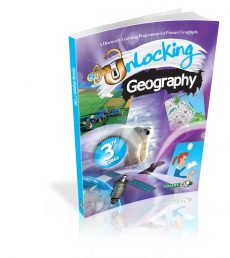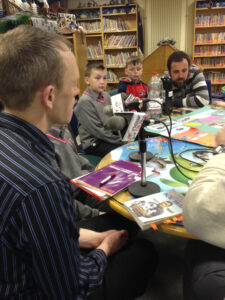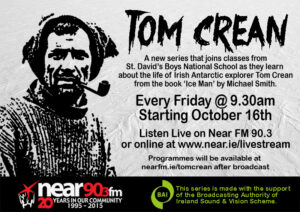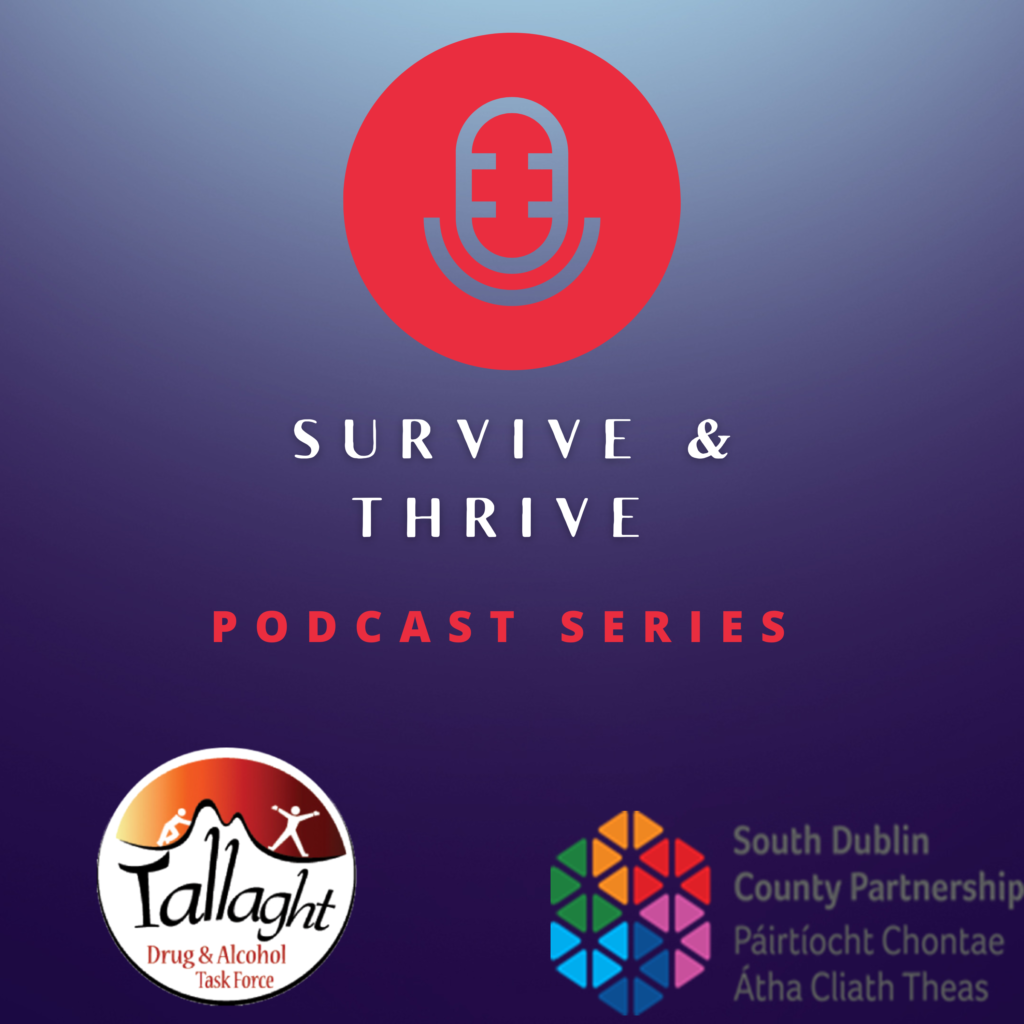Declan Cahill talks with Michael Smith, author of the Ice Man book that the Tom Crean series was based on:
Declan Cahill talks with Mr Moore, the principal of St. Davids BNS about the Tom Crean series:
Programme 1 and 2 led by Miss Cross’s class- the Antarctic, great explorers, the famine.
The Heroic Age of Antarctic Exploration
The Heroic Age of Antarctic Exploration began at the end of the 19th century and closed with Ernest Shackleton’s Imperial Trans-Antarctic Expedition in 1917. During this period the Antarctic continent became the focus of an international effort that resulted in intensive scientific and geographical exploration and in which 17 major Antarctic expeditions were launched from ten countries. The prize of the Heroic age was to reach the South Pole. Two expeditions set off in 1910 to attain this goal; a party led by Norwegian polar explorer Roald Amundsen from the ship Fram and Robert Falcon Scott’s British group from the Terra Nova.
Amundsen succeeded in reaching the Pole on 14 December 1911 using a route from the Bay of Whales to the polar plateau via the Axel Heiberg Glacier.
Scott and his four companions reached the South Pole via the Beardmore route on 17 January 1912, 33 days after Amundsen. All five died on the return journey from the Pole, through a combination of starvation and cold. The Amundsen–Scott South Pole Station was later named after these two men.
The Great Famine
The Great Famine (Irish: an Gorta Mór) or the Great Hunger was a period of mass starvation, disease, and emigration in Ireland between 1845 and 1852. It is sometimes referred to, mostly outside Ireland, as the Irish Potato Famine, because about two-fifths of the population was solely reliant on this cheap crop for a number of historical reasons. During the famine, approximately 1 million people died and a million more emigrated from Ireland, causing the island’s population to fall by between 20% and 25%.
The proximate cause of famine was Phytophthora infestans, a potato disease commonly known as potato blight, which ravaged potato crops throughout Europe during the 1840s. However, the impact in Ireland was disproportionate, as one third of the population was dependent on the potato for a range of ethnic, religious, political, social, and economic reasons, such as land acquisition, absentee landlords, and the Corn Laws, which all contributed to the disaster to varying degrees and remain the subject of intense historical debate.
The famine was a watershed in the history of Ireland. Its effects permanently changed the island’s demographic, political, and cultural landscape. For both the native Irish and those in the resulting diaspora, the famine entered folk memory and became a rallying point for various Irish Home Rule and United Ireland movements, as the whole island was then part of the United Kingdom of Great Britain and Ireland.
The massive famine soured the already strained relations between many of the Irish people and the British Crown, heightening Irish republicanism, which eventually led to Irish independence in the next century. Modern historians regard it as a dividing line in the Irish historical narrative, referring to the preceding period of Irish history as “pre-Famine”.
Programme 3 and 4 led by Mr Bedford’s class – WW1, Vikings and local natural environment.
World War I
World War I, also known as the First World War or the Great War, was a global war centered in Europe that began on 28 July 1914 and lasted until 11 November 1918. More than 9 million combatants and 7 million civilians died as a result of the war, a casualty rate exacerbated by the belligerents’ technological and industrial sophistication, and tactical stalemate. It was one of the deadliest conflicts in history, paving the way for major political changes, including revolutions in many of the nations involved.
The war drew in all the world’s economic great powers, assembled in two opposing alliances: the Allies (based on the Triple Entente of the United Kingdom/British Empire, France and the Russian Empire) and the Central Powers of Germany and Austria-Hungary. Although Italy had also been a member of the Triple Alliance alongside Germany and Austria-Hungary, it did not join the Central Powers, as Austria-Hungary had taken the offensive against the terms of the alliance. These alliances were reorganised and expanded as more nations entered the war: Italy, Japan and the United States joined the Allies, and the Ottoman Empire and Bulgaria the Central Powers. More than 70 million military personnel, including 60 million Europeans, were mobilised in one of the largest wars in history. The trigger for war was the 28 June 1914 assassination of Archduke Franz Ferdinand of Austria, heir to the throne of Austria-Hungary, by Yugoslav nationalist Gavrilo Princip in Sarajevo. This set off a diplomatic crisis when Austria-Hungary delivered an ultimatum to the Kingdom of Serbia, and entangled international alliances formed over the previous decades were invoked. Within weeks, the major powers were at war and the conflict soon spread around the world.
On 28 July, the Austro-Hungarians declared war on Serbia and subsequently invaded. As Russia mobilised in support of Serbia, Germany invaded neutral Belgium and Luxembourg before moving towards France, leading United Kingdom to declare war on Germany. After the German march on Paris was halted, what became known as the Western Front settled into a battle of attrition, with a trench line that would change little until 1917. Meanwhile, on the Eastern Front, the Russian army was successful against the Austro-Hungarians, but was stopped in its invasion of East Prussia by the Germans. In November 1914, the Ottoman Empire joined the Central Powers, opening fronts in the Caucasus, Mesopotamia and the Sinai. Italy joined the Allies in 1915 and Bulgaria joined the Central Powers in the same year, while Romania joined the Allies in 1916, and the United States joined the Allies in 1917.
The Russian government collapsed in March 1917, and a subsequent revolution in November brought the Russians to terms with the Central Powers via the Treaty of Brest Litovsk, which constituted a massive German victory until nullified by the 1918 victory of the Western allies. After a stunning Spring 1918 German offensive along the Western Front, the Allies rallied and drove back the Germans in a series of successful offensives. On 4 November 1918, the Austro-Hungarian empire agreed to an armistice, and Germany, which had its own trouble with revolutionaries, agreed to an armistice on 11 November 1918, ending the war in victory for the Allies.
Antarctica
Antarctica is Earth’s southernmost continent, containing the geographic South Pole. It is situated in the Antarctic region of the Southern Hemisphere, almost entirely south of the Antarctic Circle, and is surrounded by the Southern Ocean. At 14,000,000 square kilometres (5,400,000 square miles), it is the fifth-largest continent in area after Asia, Africa, North America, and South America. For comparison, Antarctica is nearly twice the size of Australia. About 98% of Antarctica is covered by ice that averages 1.9 kilometres (1.2 mi) in thickness, which extends to all but the northernmost reaches of the Antarctic Peninsula.
Antarctica, on average, is the coldest, driest, and windiest continent, and has the highest average elevation of all the continents. Antarctica is considered a desert, with annual precipitation of only 200 mm (8 in) along the coast and far less inland. The temperature in Antarctica has reached −89 °C (−129 °F), though the average for the third quarter (the coldest part of the year) is −63 °C (−81 °F). There are no permanent human residents, but anywhere from 1,000 to 5,000 people reside throughout the year at the research stations scattered across the continent. Organisms native to Antarctica include many types of algae, bacteria, fungi, plants, protista, and certain animals, such as mites, nematodes, penguins, seals and tardigrades. Vegetation, where it occurs, is tundra.
Antarctica is a de facto condominium, governed by parties to the Antarctic Treaty System that have consulting status. Twelve countries signed the Antarctic Treaty in 1959, and thirty-eight have signed it since then. The treaty prohibits military activities and mineral mining, prohibits nuclear explosions and nuclear waste disposal, supports scientific research, and protects the continent’s ecozone. Ongoing experiments are conducted by more than 4,000 scientists from many nations.
Vikings
Vikings (Norwegian and Danish: Vikinger; Swedish and Nynorsk: Vikingar; Icelandic: Víkingar), from Old Norse víkingr, were Germanic Norse seafarers, speaking the Old Norse language, who raided and traded from their Scandinavian homelands across wide areas of northern and central Europe, as well as European Russia, during the late 8th to late 11th centuries. The term is also commonly extended in modern English and other vernaculars to the inhabitants of Viking home communities during what has become known as the Viking Age. This period of Norse military, mercantile and demographic expansion constitutes an important element in the early medieval history of Scandinavia, the British Isles, France, Kievan Rus’ and Sicily.
Facilitated by advanced seafaring skills, and characterised by the longship, Viking activities at times also extended into the Mediterranean littoral, North Africa, the Middle East and Central Asia. Following extended phases of (primarily sea- or river-borne) exploration, expansion and settlement, Viking (Norse) communities and polities were established in diverse areas of north-western Europe, European Russia, the North Atlantic islands and as far as the north-eastern coast of North America. This period of expansion witnessed the wider dissemination of Norse culture, while simultaneously introducing strong foreign cultural influences into Scandinavia itself, with profound developmental implications in both directions.
Popular, modern conceptions of the Vikings—the term frequently applied casually to their modern descendants and the inhabitants of modern Scandinavia—often strongly differ from the complex picture that emerges from archaeology and historical sources. A romanticized picture of Vikings as noble savages began to emerge in the 18th century; this developed and became widely propagated during the 19th-century Viking revival. Perceived views of the Vikings as alternatively violent, piratical heathens or as intrepid adventurers owe much to conflicting varieties of the modern Viking myth that had taken shape by the early 20th century. Current popular representations of the Vikings are typically based on cultural clichés and stereotypes, complicating modern appreciation of the Viking legacy.
Programme 5 and 6 led by Ms Cahill’s class – the weather, mountain glaciers, climate, cartography and 19th Century Ireland.
Climate
Antarctica is the coldest of Earth’s continents. The coldest natural temperature ever recorded on Earth was −89.2 °C (−128.6 °F) at the Soviet (now Russian) Vostok Station in Antarctica on 21 July 1983.] For comparison, this is 11 °C (20 °F) colder than subliming dry ice at one atmosphere of partial pressure, but since CO2 only makes up 0.039% of air, temperatures of less than −150 °C (−238 °F) would be needed to produce dry ice snow in Antarctica. Antarctica is a frozen desert with little precipitation; the South Pole itself receives less than 10 cm (4 in) per year, on average. Temperatures reach a minimum of between −80 °C (−112 °F) and −90 °C (−130 °F) in the interior in winter and reach a maximum of between 5 °C (41 °F) and 15 °C (59 °F) near the coast in summer. Sunburn is often a health issue as the snow surface reflects almost all of the ultraviolet light falling on it. Given the latitude, long periods of constant darkness or constant sunlight create climates unfamiliar to human beings in much of the rest of the world.
East Antarctica is colder than its western counterpart because of its higher elevation. Weather fronts rarely penetrate far into the continent, leaving the centre cold and dry. Despite the lack of precipitation over the central portion of the continent, ice there lasts for extended periods. Heavy snowfalls are common on the coastal portion of the continent, where snowfalls of up to 1.22 metres (48 in) in 48 hours have been recorded.
At the edge of the continent, strong katabatic winds off the polar plateau often blow at storm force. In the interior, wind speeds are typically moderate. During clear days in summer, more solar radiation reaches the surface at the South Pole than at the equator because of the 24 hours of sunlight each day at the Pole
Antarctica is colder than the Arctic for three reasons. First, much of the continent is more than 3,000 m (9,800 ft) above sea level, and temperature decreases with elevation in the troposphere. Second, the Arctic Ocean covers the north polar zone: the ocean’s relative warmth is transferred through the icepack and prevents temperatures in the Arctic regions from reaching the extremes typical of the land surface of Antarctica. Third, the Earth is at aphelion in July (i.e., the Earth is furthest from the Sun in the Antarctic winter), and the Earth is at perihelion in January (i.e., the Earth is closest to the Sun in the Antarctic summer). The orbital distance contributes to a colder Antarctic winter (and a warmer Antarctic summer) but the first two effects have more impact.
Glaciers
A glacier is a persistent body of dense ice that is constantly moving under its own weight; it forms where the accumulation of snow exceeds its ablation (melting and sublimation) over many years, often centuries. Glaciers slowly deform and flow due to stresses induced by their weight, creating crevasses, seracs, and other distinguishing features. They also abrade rock and debris from their substrate to create landforms such as cirques and moraines. Glaciers form only on land and are distinct from the much thinner sea ice and lake ice that form on the surface of bodies of water.
On Earth, 99% of glacial ice is contained within vast ice sheets in the polar regions, but glaciers may be found in mountain ranges on every continent except Australia, and on a few high-latitude oceanic islands. Between 35°N and 35°S, glaciers occur only in the Himalayas, Andes, Rocky Mountains, a few high mountains in East Africa, Mexico, New Guinea and on Zard Kuh in Iran. Glaciers cover about 10 percent of Earth’s land surface. Continental glaciers cover nearly 5 million square miles of Antarctica’s 5.1 million square miles, with an average thickness of 7,000 feet. Greenland and Patagonia also have huge expanses of continental glaciers.
Glacial ice is the largest reservoir of freshwater on Earth. Many glaciers from temperate, alpine and seasonal polar climates store water as ice during the colder seasons and release it later in the form of meltwater as warmer summer temperatures cause the glacier to melt, creating a water source that is especially important for plants, animals and human uses when other sources may be scant. Within high altitude and Antarctic environments, the seasonal temperature difference is often not sufficient to release meltwater.
Because glacial mass is affected by long-term climate changes, e.g., precipitation, mean temperature, and cloud cover, glacial mass changes are considered among the most sensitive indicators of climate change and are a major source of variations in sea level.
A large piece of compressed ice, or a glacier, appears blue as large quantities of water appear blue. This is because water molecules absorb other colors more efficiently than blue. The other reason for the blue color of glaciers is the lack of air bubbles. Air bubbles, which give a white color to ice, are squeezed out by pressure increasing the density of the created ice.
Programme 7 and 8 led by Mr Minogue’s class – water, other countries mentioned in the novel such as Chile and England as well as transport and technology.
Water
Water (chemical formula: H2O) is a transparent fluid which forms the world’s streams, lakes, oceans and rain, and is the major constituent of the fluids of organisms. As a chemical compound, a water molecule contains one oxygen and two hydrogen atoms that are connected by covalent bonds. Water is a liquid at standard ambient temperature and pressure, but it often co-exists on Earth with its solid state, ice; and gaseous state, steam (water vapor). It also exists as snow, fog, dew and cloud.
Water covers 71% of the Earth’s surface. It is vital for all known forms of life. On Earth, 96.5% of the planet’s crust water is found in seas and oceans, 1.7% in groundwater, 1.7% in glaciers and the ice caps of Antarctica and Greenland, a small fraction in other large water bodies, and 0.001% in the air as vapor, clouds (formed of ice and liquid water suspended in air), and precipitation. Only 2.5% of this water is freshwater, and 98.8% of that water is in ice (excepting ice in clouds) and groundwater. Less than 0.3% of all freshwater is in rivers, lakes, and the atmosphere, and an even smaller amount of the Earth’s freshwater (0.003%) is contained within biological bodies and manufactured products. A greater quantity of water is found in the earth’s interior.
Water on Earth moves continually through the water cycle of evaporation and transpiration (evapotranspiration), condensation, precipitation, and runoff, usually reaching the sea. Evaporation and transpiration contribute to the precipitation over land. Water used in the production of a good or service is known as virtual water.
Safe drinking water is essential to humans and other lifeforms even though it provides no calories or organic nutrients. Access to safe drinking water has improved over the last decades in almost every part of the world, but approximately one billion people still lack access to safe water and over 2.5 billion lack access to adequate sanitation. There is a clear correlation between access to safe water and gross domestic product per capita. However, some observers have estimated that by 2025 more than half of the world population will be facing water-based vulnerability. A report, issued in November 2009, suggests that by 2030, in some developing regions of the world, water demand will exceed supply by 50%. Water plays an important role in the world economy, as it functions as a solvent for a wide variety of chemical substances and facilitates industrial cooling and transportation. Approximately 70% of the freshwater used by humans goes to agriculture.
Chile
Chile, officially the Republic of Chile, is a South American country occupying a long, narrow strip of land between the Andes to the east and the Pacific Ocean to the west. It borders Peru to the north, Bolivia to the northeast, Argentina to the east, and the Drake Passage in the far south. Chilean territory includes the Pacific islands of Juan Fernández, Salas y Gómez, Desventuradas, and Easter Island in Oceania. Chile also claims about 1,250,000 square kilometres (480,000 sq mi) of Antarctica, although all claims are suspended under the Antarctic Treaty.
The arid Atacama Desert in northern Chile contains great mineral wealth, principally copper. The relatively small central area dominates in terms of population and agricultural resources, and is the cultural and political center from which Chile expanded in the late 19th century when it incorporated its northern and southern regions. Southern Chile is rich in forests and grazing lands, and features a string of volcanoes and lakes. The southern coast is a labyrinth of fjords, inlets, canals, twisting peninsulas, and islands.
Spain conquered and colonised Chile in the mid-16th century, replacing Inca rule in northern and central Chile, but failing to conquer the independent Mapuche that inhabited south-central Chile. After declaring its independence from Spain in 1818, Chile emerged in the 1830s as a relatively stable authoritarian republic. In the 19th century, Chile saw significant economic and territorial growth, ending Mapuche resistance in the 1880s and gaining its current northern territory in the War of the Pacific (1879–83) after defeating Peru and Bolivia. In the late 1960s and early 1970s, the country experienced severe left-right political polarization and turmoil. This development culminated with the 1973 Chilean coup d’état that overthrew Salvador Allende’s left-wing government and instituted a 16-year-long right-wing military dictatorship that left more than 3,000 people dead or missing. The regime headed by Augusto Pinochet ended in 1990 after it lost a referendum in 1988 and was succeeded by a centre-left coalition which ruled through four presidencies until 2010.
Chile is today one of South America’s most stable and prosperous nations. It leads Latin American nations in rankings of human development, competitiveness, income per capita, globalization, state of peace, economic freedom, and low perception of corruption. It also ranks high regionally in sustainability of the state, and democratic development. Chile is a founding member of the United Nations, the Union of South American Nations and the Community of Latin American and Caribbean States.
Related Reading:

|

|











